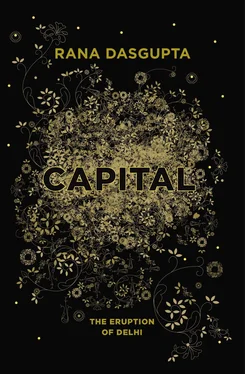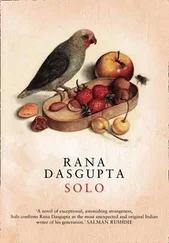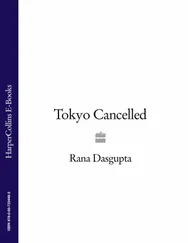Modern Delhi was born out of the catastrophe of India’s partition, whose ravages turned its culture towards security and self-reliance. The compounds in which its richest citizens take refuge from society are only the most extravagant manifestations of a more widespread isolationist ethos. Delhi is the pioneer, after all, of India’s private townships, where life is administered by corporations and surrounded by fences, and where one is cut away, therefore, from the broad currents of the country. Gurgaon, the Delhi suburb established by real estate giant DLF in the 1990s, is the largest such township in Asia, and now has imitators all over the country. An expanse of fields until thirty years ago, Gurgaon’s looming apartment blocks and steely towers now look as if they have emerged from a computer game set in some super-saturated future. Gurgaon makes no pretence of being a ‘public’ space: the great numbers of the poor who clean and guard its houses and offices, for instance, cannot live there. To live in Gurgaon is to live in a housing complex protected from the outside by security cameras and armed guards, where residents pay corporations to service all their fundamental needs: garbage collection, water supply and even, in the frequent event that state-owned electricity fails, electricity generation. It therefore appeals to a group of people for whom the corporation has come to seem a far more fertile form of social organisation than the state, and who seek out enclaves of efficient, post-public living.
The place where I now sip my bottled water is venerable. For far in excess of a millennium, men and women have made their lives on the soil where my feet now rest. From my seat by the pool I can gaze up at the soaring trunk of the Qutab Minar, the triumphal tower built in the wake of an ancient conquest of Delhi by central Asian invaders: massive and serrated, it has punctured eight centuries of evenings like this, the only man-made thing, even now, to make any claim on these fallow skies.
In this landscaped compound, every attempt has been made to carpet over the land. But in the nearby woods and wastelands, by the sides of all the roads hereabout, ornate tombs, palaces and mosques press up from the obstinate past — and, waiting here in the gathering night, I sense, even through the hard crust of twenty-first century cement, ghosts rising from the earth, the spirits of those who, for hundreds of years, herded cattle, raised crops, worshipped gods, built settlements, made song, petitioned rulers, buried their dead. Just here, where these mute paths now run perfectly level, on this soil now sealed with emerald lawns.
From the chlorinated depths of the pool rises something else: the recollection of a dream. Eight centuries ago, a few paces away from here, the sultan Iltutmish lay sleeping. Suddenly the doors of his slumber burst open — and there before him was the Prophet Mohammad mounted on the winged steed of Heaven, Buraq. Buraq looked at the sultan with a face that was sometimes man, sometimes woman and sometimes horse; the quivering of its mighty wings produced an indomitable gale. The sultan felt he was being called and, as horse and rider withdrew, he followed them. When they reached a certain place, the horse struck the earth with its hoof, and from the ground spurted a jet of water.
And the chamber of the dream closed again.
In the morning, the sultan went to the place where he had been led in the dream. When he arrived, he saw on the ground a sign — the imprint of Buraq’s mighty hoof — and he gave orders for the digging of a new reservoir. Before long there was built a magnificent lake with a mosque in the centre, accessible by boat; there were grand villas all around the waterside, and a vast encampment for all the musicians needed to entertain such an assembly — and the people gave thanks for their ruler’s wise and glorious works.
Iltutmish also constructed a five-storey-deep step-well nearby, surrounded by colonnaded terraces where townsfolk could meet and chat by the water. A second step-well, conceived on an even more lavish scale, was sunk next to it a couple of centuries later, so that this place of blistering summers became famous among travellers for the abundance of its water.
The reason these tanks were so bountiful had to do with their position. They were situated at the end of the long and rocky slope that channelled water down from the Aravalli mountains, the ancient range which gnarls India from the state of Gujarat almost all the way to the city of Delhi. In this landscape of brush and dust, moreover, the wells were placed in a forest whose densely rooted soil did not blow away or silt up the system but held water like a sponge and even filtered it in the process. For such reasons, these community tanks were full of water for more than six centuries. As late as the 1960s, they provided sport to local boys who performed the startling feat of diving to the bottom to fish out coins.
Now they are just dry craters in the ground, littered at the bottom with plastic bags and dead pigeons.
It is not just that groundwater levels have plummeted in these decades of ever more intensive extraction, when the number of those packed together in this baked place edges towards the twenty millions. It is also that these wells depended on a delicate and extensive field of capillary action, which has since been carved up by the superstructure of modern life. The profusion of concrete surfaces prevents water from being absorbed into those capillaries, which anyway are greatly depleted by the disappearance of the forests. Industrial drainage systems carry water away from its ancient courses. Tarmac roads interrupt the age-old seep.
The crackle of such ruptures is barely audible to the modern ear. These recent impositions are so much a part of our being that it is difficult for us to appreciate the greatness of the other, alien, arrangements with which they have done away. We are programmed to consider pre-modern engineering infantile, and to treat with scepticism the phantasmagorical dreams of medieval emperors. But when you watch women in the contemporary city gathering water for their families from dripping pipelines or from flooded potholes, the majesty of the dream, and the great works performed in its name, can impress itself upon you again.
Is it because of this history that it feels so deeply apt to sit next to this swimming pool? Pools, after all, have been Delhi’s salvation for centuries. And in our superstitious epoch when water is faith, not science, when the old tanks stand dry, their technology forgotten, when house dwellers have little clue where their water comes from, when everyone is desperately pumping from the earth whatever they can while they still can — there is something decadently exquisite about this calm and pregnant pool.
• • •
Rakesh comes out to meet me at a jog. We have not met before. He exudes immediate charm, which derives partly from the way he throws himself into our encounter, holding nothing back. He looks me straight in the eye as he talks and he frequently slips my first name into the conversation. He arranges wine for me, and makes sure I like it. Such manners are de rigueur for Delhi businessmen, masters of persuasion — but I enjoy them nonetheless.
“Frankly, I was trying to dodge you for some time,” he smiles. “I never talk about myself or what I do. I don’t do anything for the world to know about it. If I do something, I do it for myself, I do it for my family and I do it for my friends. For nobody else. I don’t give a fuck what anyone else thinks.”
Two plates of assorted hors d’oeuvres are brought. One each.
“But then I spoke to Mickey. We discussed you. He said you were okay. So I decided to tell you my story.”
What surprises me about Delhi business families is how few levels of formality there are. Doors are securely closed until they are not — and then everything is open. If you have come with the approval of a friend, you are automatically a ‘bro’ — as the slang goes. This is the clannish ethos, by turns charming and infuriating, by which so much of the city functions.
Читать дальше











